We all know what happens when a group of art students sit round a model to draw: each represents the model according to his own viewpoint and his own ability. Together they will give the whole model, but fragmented; something will be missing from each of the pictures, even the ablest, and some may render the person as a composition of primary geometrical forms.
I t will be no different when many artists illustrate the same text, such as a fairy tale by Hans Christian Andersen. The place, time, style and intention of each will impart his character to the Andersen situation or person. What adjectives one will apply to this character are another matter.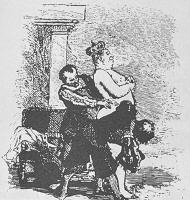
A handful of Andersen's tales, merely in Danish and in book form, muster more than twenty illustrators, and they are very largely the same tales that have gone furthest internationally, to a hundred languages and countless artists.
Bertall. Contes. France 1856 One of the most universal is 'The Emperor's New Clothes', written in 1837 and modelled on a medieval Spanish tale which Andersen read in anew German translation. The popularity is understandable. The tale is very amusing, its point has long since become a common quotation; and who would not identify himself with something as likeable as a small child, and with the title of a fairy tale dismiss incomprehensible problems as if they were non-existent. That expedient at any rate is one of the reasons for the marked use of this title in Andersen's homeland. 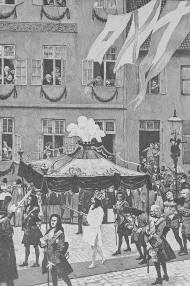
Hans Tegner. Fairy Tales (Word Edition). Denmark 1900. The first Andersen illustrations in book form were German; our tale was included, G: Osterwald etching the minister and the weavers in an interior that was old-fashioned in relation to the book's date, 1839.
The emperor in procession, however, we see in the drawing of the classic Danish illustrator Vilhelm Pedersen ten years later. The style character here is Renaissance. Some fifty years later, another Dane, Hans Tegner, drew the procession in a townscape of real Copenhagen houses of the period after the fire of 1729, giving the spectators features of early-nineteenth-century costumes.
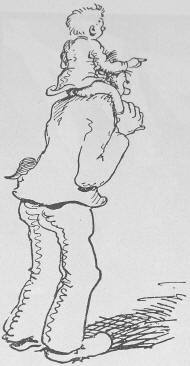
Albert Merckling. Miirchen (translated by Rudolf Eger). Switzerland 1944.
Liveries and uniforms, of course, are older in character, and Tegner's realistic local approach is clear . His drawings were used in fine xylographic reproduction in the so-called World Edition, in many languages, of 1900.
Most artists aim at a late-Baroque or Rococo setting of the tale; but it is highly probable that the Japanese Yanagita Kenyoshi (1934) knew something about Andersen's source. At any rate, his procession can very well be construed as Spanish Renaissance set against medieval walls. In any case, it is not Japanese.
One can go further and choose an abstract orientalizing milieu, as the British Beardsley imitator Harry Clarke (1916) did in most of his fairy-tale drawings, as also here. The scene could be from The Arabian Nights, though they scarcely used suspenders there. One can also go the reverse way and have ordinary contemporary people witness the strange event. This is the method of an anonymous Rumanian in 1931 and of Albert Merckling in a German edition from Zurich in 1944.
Social or political engagement? 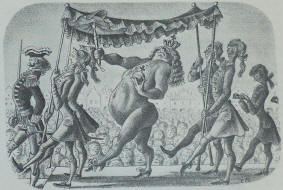
Cyril Bouda. Poh!idky a Povidky. Czechoslovakia 1956. For all their differences, these artists are mostly narrative; they leave the satire to emerge indirectly. Others depict the emperor and his flunkeys as caricatures, which is scarcely true to Andersen. Cyril Bouda's emperor in a large Czech collection of fairy tales of 1956 has borrowed features from a fat pig, while on the other hand his lackeys are scraggy , and the officer in front has all the impeccable stupidity which belongs to this caricature type. Considerably more spiteful is a rare private edition by Michel Ell (Berlin 1923) , who in expressionistic woodcuts in the spirit of Franz Masereel displays perverted power in the faces.
Presumably in this tendency there is a social or political engagement; but one must be careful about generalizing. For instance, one need not expect Russian and other artists from anti-imperialist or anti-bourgeois societies to o¥erdo the satire against emperors or sympathy for the poor and weak in Andersen's tales. It is an exceptional case when the final scene in 'The Tinderbox' represents a crudely caricatured court with a pig's head in the coat of arms, as opposed to a stout soldier in Russian working clothes. The specimen can be seen in V. Konasevic's drawing for an edition in Tartar (Kazan 1952).
Common decency
Regardless of choice of milieu and basic approach, the many artists have to take sides in a third respect, both as regards weaving and as regards common decency. What are the weavers to be doing? What is the meaning of the words 'new clothes'? 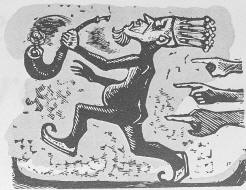
Huang Yung-Yu. Illustration of Yeh Sheng-tao's The Scarecrow. Peking 1961.
The subject is not particularly interesting, but a position has to be taken. Vilhelm Pedersen, who even provides the Little Mermaid's underwater statue of the prince with an apron, of course draws the emperor in his shirt, and this reasonable expedient is followed by many, while the aforesaid Rumanian and others give him a loin-cloth or long trousers. Few seem to have missed the complete physical exposure, although a young woman 'ideology-critical' writer has recently confessed to doing so in Pedersen's interpretation.
In fact there have been artists, quite early, who have shown the emperor with nothing on but insignia, sashes or the like, but they always, to be sure, mitigated the sight by having the weavers or the crowd 'stand in the way'. The Finn Erkki Tanttu (1955) and the internationally known Pole J anusz Grabianski a few years later gave the emperor almost identical costume and bulk, in front of the mirror and in the procession.
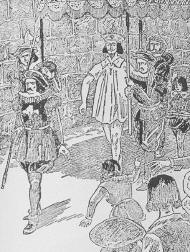 Yanagita Kenyoshi. Doji-Wa. Japan 1934.
To this degree of decency belongs Bertall's drawing for the classic French edition of 1856. But here we return sharply from the spirit of decorum to the very robust sphere of politics: the title in all editions is' Les habits neuts du grandduc'. All right, there are so many retouchings in the Andersen translations. But the list of contents of the first impression gives, not 'grand duke', but 'emperor', as usual. A translator, publisher, censor -who knows? -had scruples; but an editor or printer has omitted, unintentionally or deliberately, to alter Napoleon Ill's title in the contents table!
...We will leave our subject and allow His Majesty to gallop naked off to the left, pursued by an incensed populace that had already lost hundreds of heads and refused to submit to the stripped emperor's unbending tyranny. First he would not listen to criticism; then he would only wear the new clothes; then, under pain of death, he would have forbidden any sort of noise within hearing of his processions. How fair and right that high and low set upon and dethroned this stupid and wicked ruler .
This further development is by Yeh Sheng-tao and the artist Huang Yung-yu, and is from the English-language book The Scarecrow, Peking 1961. 'Such works are mirrors. ..' as Lichtenberg's aphorism begins.
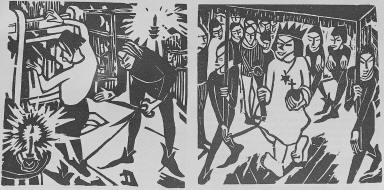
Michel Ell. Des Kaisers neue Kleider. Germany 1923.
Literature: Les habits neufs de l'empereur en vingt-cinq langues, pub lie par Louis Hjelmslev & Axel Sandal. Copenhague 1944. Erik Dal: Udenlandske H. C. Andersen-illustrationer (Foreign H. C. Andersen Illustrations. 100 pictures from 1838 to 1968). Copenhagen 1969.
The author: Erik Dal, born 1922, dr phil 1960, was formerly with the Royal Library and the Danish School of Librarianship and is now Administrator of the Danish Language and Literature Society. His extensive scholarly work has chiefly concentrated on folk-ballad research, Danish literature of the seventeenth century, Hans Christian Andersen and bibliography.
|